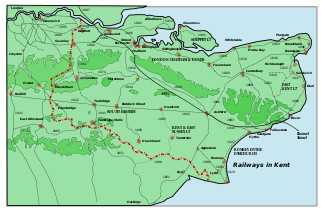Westerham railway station
| Westerham | |
|---|---|
 | |
| Location | |
| Place | Westerham |
| Area | Sevenoaks |
| Grid reference | TQ448544 |
| Operations | |
| Pre-grouping |
South Eastern Railway SECR |
| Post-grouping |
Southern Railway Southern Region of British Railways |
| Platforms | 1 |
| History | |
| 3 July 1881[1] | Opened |
| 30 October 1961[1] | Closed |
| Disused railway stations in the United Kingdom | |
|
Closed railway stations in Britain A B C D–F G H–J K–L M–O P–R S T–V W–Z | |
|
| |

Westerham railway station served the village of Westerham in Kent from 1881 until its closure in 1961.
History
No railway was ever constructed all the way between Sevenoaks and Redhill to parallel what is now the A25 road and the Pilgrims' Way. Reasons for this may include: a) the Redhill to Tonbridge Line had been built quite early in railway history and served the settlements between Redhill and Godstone, b) the difficult choice between boggy land in the valley bottom and the gradients encountered on the A25 route at Limpsfield and Nutfield, c) the "pull" of London which meant that the emphasis was on radial routes from the capital.
However, in 1881 the Westerham Valley Railway Company built the Westerham Valley Branch Line from the South Eastern Main Line at Dunton Green to Westerham with one intermediate station at Brasted. The branch was built as single track with provision for double track as an ambitious extension to Oxted was envisaged. The South Eastern Railway took over the company soon after construction, itself becoming part of the South Eastern and Chatham Railway in 1899. The Southern Railway took over responsibility for the line upon the railway grouping in 1923, followed by the Southern Region of British Railways upon nationalisation in 1948.
The line was ostensibly closed in 1961 due to low patronage[1] and was the subject of a revival/preservation attempt which was scuppered by plans for the M25 which called for the use of much of the line.[1] The Westerham Valley Railway Association had succeeded in obtaining a lease of Westerham Station from British Rail in April 1962 and had carried out maintenance works. However, this was no avail when, faced with the determination of Kent County Council to realise the construction of the M25, the Association was unable to meet the costs of constructing an overbridge for the motorway at Chevening and the Council promptly in-filled the section, effectively cutting the line in two. The station buildings demolished and track lifted by March 1967.[2]
Present day
The Westerham Flyer, the Class H 0-4-4T No. 31518 locomotive which pulled the morning trains on the last day of service on Saturday 26 October 1961, is remembered in the name of the industrial estate which covers the footprint of the former station site and goods yard. "The Flyers Way Industrial Estate", served by "The Flyers Way" road, is made up of six light industrial units and backs on to original railway cottages. There is no plaque to commemorate the station's history, the only reminder of it being the base of the goods yard crane which is situated on a grass verge near the entrance to the site. It is, however, possible to trace the line of the trackbed eastwards around the site, past the railway cottages on an embankment and into nearby allotments.
| Preceding station | Disused railways | Following station | ||
|---|---|---|---|---|
| Terminus | British Rail Southern Region Westerham branch |
Brasted | ||
Gallery
 The Flyers Way
The Flyers Way Base of the goods yard crane
Base of the goods yard crane The Flyer's Way Industrial Estate
The Flyer's Way Industrial Estate Trackbed and embankment going east from the station
Trackbed and embankment going east from the station Trackbed passing through nearby allotments
Trackbed passing through nearby allotments
Other stations
See also
References
External links
Coordinates: 51°16′13″N 0°04′28″E / 51.27036°N 0.07431°E